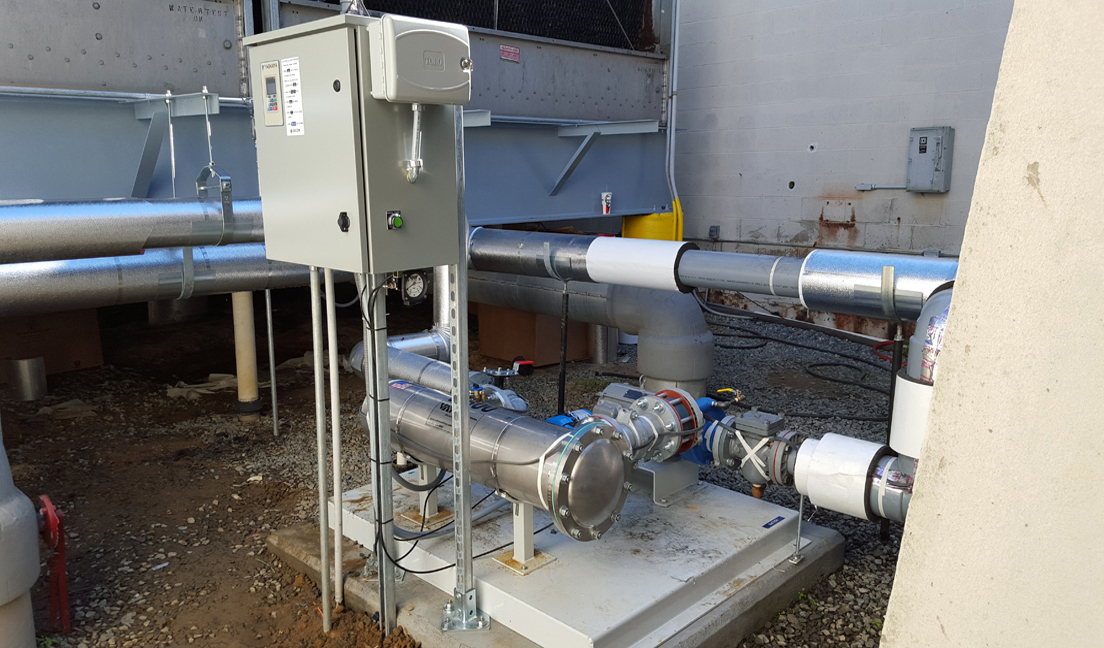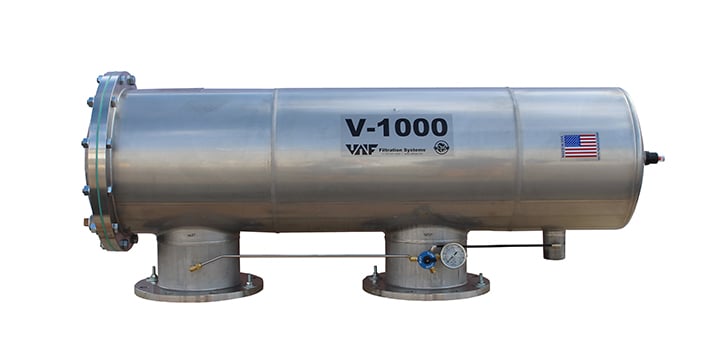Challenge
A medical center in Georgia needed filtration for its three 400 ton cooling towers due to fouling/corrosion issues, silt and organic accumulation in the basins resulting in Legionella habitat buildup, and replacement of cooling tower fill due to plugged fill channels from unfiltered cooling water.
Originally, sand media filtration had been specified for the medical center‘s cooling tower system. The objective was to clean the basins directly before any debris had a chance to enter the cooling system and reduce the habitat for Legionella bacteria living in the deposits in the basin. After reviewing the media system with the mechanical engineering firm assisting with the project, a self-cleaning screen filtration technology was determined to be a better fit for this application for the following reasons:
- Limited space requirements. The media systems would require one large media vessel per two cooling tower cells. The space required for two systems of this size was a real concern as well as the expense for the electrical, water supply and sewer drains that would be required. Automatic screen filtration requires about half the footprint.
- Unacceptable large amount of backflush water required by media filtration. A fresh potable water supply, which had to be heat traced, would have been required to each vessel for backflushing. Each vessel would have had a filter rate of 57 m3/hr (251 gpm) and would have required a two minute, 57 m3/hr (1,893 liters) or 251 gpm (500 gallons) backflush cycle. Automatic screen filtration requires about 1/10th the amount of flush water.
- Excessive energy requirements required for the proposed media system. The media filtration system required a 7.5 hp pump for each two vessel system resulting in 22.5 hp pumps running 24 hours per day. This would have resulted in a significant increase in the medical center's annual energy expense estimated at $19,021 (assuming $0.11/kWh energy cost and best pump efficiency point of 85%).
Solution
Evoqua's VAF LCFX system was selected as the system of choice for the following reasons:
- Only one 10HP pump required to provide basin cleaning for the entire 1200 ton cooling tower
- 55% reduction in pump size required by reducing from 22.5HP to 10HP
- 70% reduction in filtration flow rate per tower basin from 159 m3/hr to 45 m3/hr (700 gpm to 200 gpm)
- 75% reduction in operating time from 24 hours per day to only 6 hours per day for all three towers resulting in total volume turned twice a day
- 87% reduction in energy cost (energy cost for the LCFX-500-10 was $2,426.82 using a 74% efficiency and $0.11/kWh)
- 95% reduction in flush waste compared to a single tower media filter system
- The footprint of the single LCFX system skid was 122 cm x 132 cm (48" x 52"), which was a much smaller footprint than for the two media systems option
- LCFX’s flexibility of basin cleaning times based on dirt load
- LCFX’s BACnet interface for remote monitoring and operation capabilities

Results
The LCFX system has unsurpassed operating efficiencies over conventional cooling tower filtration systems while providing both basin agitation and cooling water cleaning. By combining the patented* technology of VAFTM filters and the reduction in energy usage and water saving components of the LCFX system, an ROI can be achieved in less than a year. The sophisticated zone control technology combined with variable-frequency drive (VFD)/programmable logic controller (PLC) for the pump allow for one system to clean multiple cooling towers at a low pressure and flow rate. The zone control system maintains a pressurized mainline that has zone control valves placed at each defined zone. Each zone has a specified number of turbulator agitation nozzles placed inside the basin that agitates particulate and keeps it in suspension for removal by filtration. The VFD/PLC provides energy efficiency by operating the pump only at the minimum 1.4 bar (20 psi) required for the turbulator nozzles agitation and then provides the minimum of 2 bar (30 psi) required for the filter’s 30 second flush cycle thus maintaining low energy usage for an extended period of time.
In addition, this system reduces the buildup of organics and silt found in the basin, which will help inhibit the growth of Legionella. Reduction in manual cleanings is also accomplished and corrosion/fouling issues are also noticeably alleviated.
*Patented in some countries

